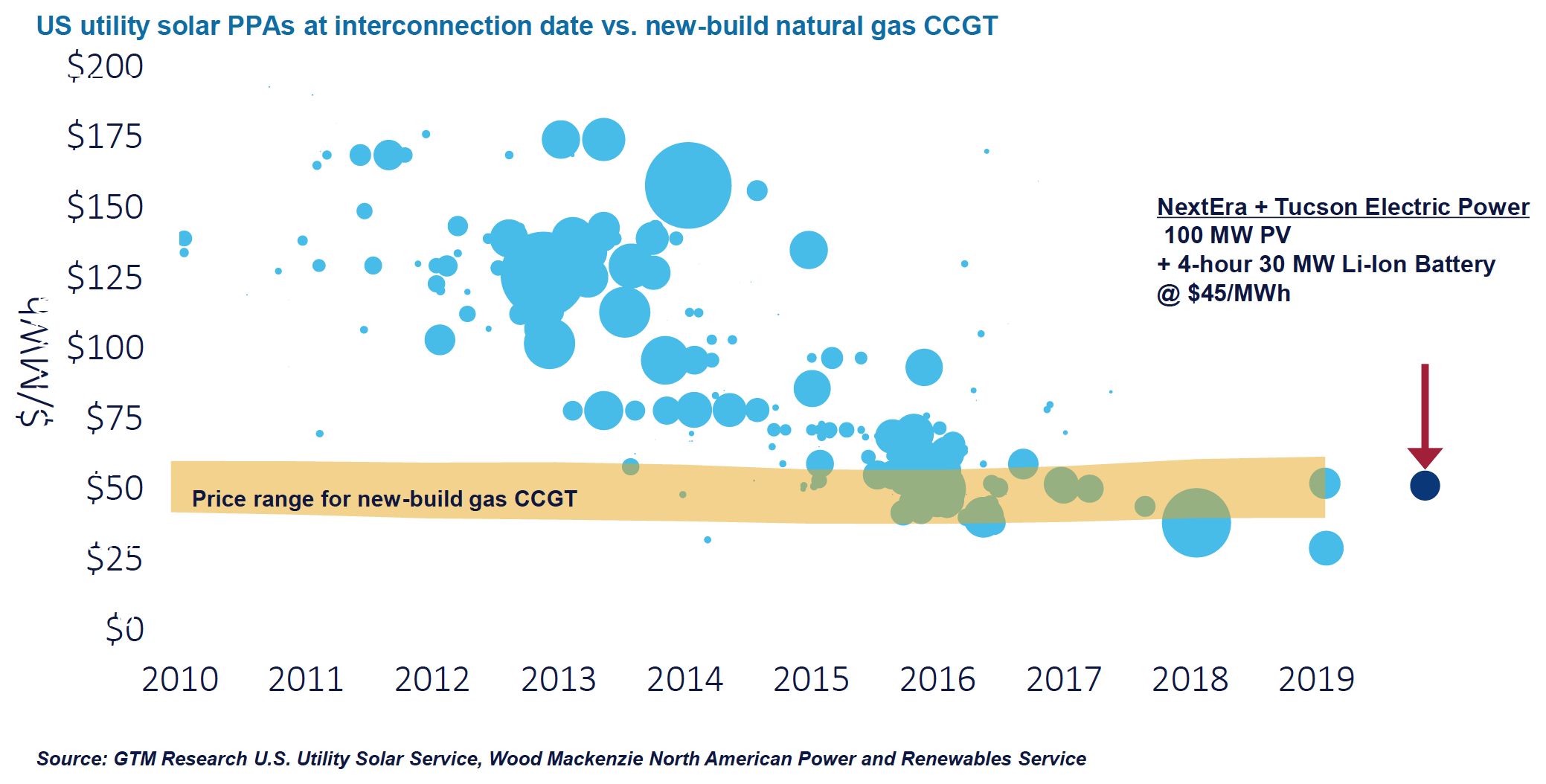The scale of the threat facing gas-based electricity generation from renewables and energy storage was outlined this week at the Global Power & Energy Exhibition in Barcelona, Spain.
Rory McCarthy, senior storage analyst for Wood Mackenzie Power & Renewables, illustrated for attendees how the business case for using renewables in place of natural gas is becoming more compelling following declines in solar and wind costs.
That business case is also improving as a result of massive increases in battery storage, where the U.S. leads the world in terms of operational and planned capacity.
Today, storage capacity amounts to around 6 gigawatt-hours worldwide, but Wood Mackenzie predicts a more than tenfold increase, to at least 65 gigawatt-hours, by 2022. The U.S. will continue to lead this build-out, thanks to its more mature market.

“The U.S. market is probably five years ahead of everybody else,” said McCarthy. “They did frequency regulation with energy storage a lot earlier than anyone else. But we can see China picking up the pace [and] European markets are starting to open their doors.”
The outlook up to 2022 was “just the tip of the iceberg” in terms of predicted energy storage deployment, he added. At the same time, solar and wind energy have both fallen drastically in price over the last half decade, largely thanks to the advent of government auctions.
The global solar market, for example, has smashed power-purchase agreement (PPA) records seven times since the start of 2016. Solar is now cheaper than the global levelized cost of coal and gas in Chile, Mexico and parts of the Middle East.

PV is also competitive with natural gas in the U.S., where solar prices hit $37 per megawatt-hour in 2016. Recent bids have beaten expectations on the back of ultra-low module pricing created by a huge ramp-up in production from the Chinese market, McCarthy said.
Global module prices had fallen by up to 30 percent, he said, after China dropped its solar feed-in tariff program earlier this year. Another factor helping push down solar energy pricing is the low cost of capital, a product of benign global interest rates.
“These are pretty low-risk projects,” McCarthy explained. “You can deploy a lot of debt in there, highly geared, which is good for driving prices down.”
These factors have attracted a diverse set of investors into the solar industry, from traditional energy companies to pension funds and oil and gas majors. And it’s a similar story in onshore and offshore wind.

Standalone wind is beating the levelized cost of gas globally, McCarthy remarked. But the technology, like standalone solar, has problems competing with gas because it is not dispatchable and may carry hidden grid integration costs. This is where storage comes in.
Wood Mackenzie is tracking almost a gigawatt of battery storage attached to renewable plants. Activity is strong in the U.S., Europe, Asia and Australia, home of the 129-megawatt-hour Hornsdale Power Reserve.
This nascent hybrid storage market is set to take off this year, driven mostly by increasing volumes of battery-attached solar projects, although a growing range of technology concepts is emerging.
The U.S. will lead this trend, with more than 2.5 gigawatts of hybrid storage in operation, under construction or announced. Following the U.S. will be Australia, then Japan, China, South Korea and India.
What is noteworthy about these projects is that, increasingly, the addition of storage does not appear to increase the PPA cost that developers are willing to settle for. Almost the opposite, in fact.
In May 2017, Tucson Electric Power raised eyebrows by signing a PPA with NextEra for energy from a solar-plus-storage plant costing just $45 per megawatt-hour, well within the price range for new-build combined cycle gas.
The 100-megawatt solar array and an accompanying 30-megawatt, 4-hour energy storage system, expected to be in service by the end of 2019, effectively took the place of a gas peaker, McCarthy said.

More recently, an Xcel Energy solicitation set a new solar-plus-storage record after attracting a median price of $36 per megawatt-hour. Even lower prices are expected to follow as the cost of battery storage continues to drop.
Battery prices are expected to fall by more than 80 percent by 2040. “We’re going to see production quadruple by 2025,” said McCarthy. “And with every doubling in capacity, we see a 5 to 8 percent reduction in costs.”

Recent research by Wood Mackenzie Power & Renewables has shown that battery systems could already replace the roughly 67 percent of U.S. gas turbines that have capacity factors below 10 percent.
And in places such as South Australia, batteries were already being regarded as a rival to gas peakers more than a year ago. Today that threat seems very real.



